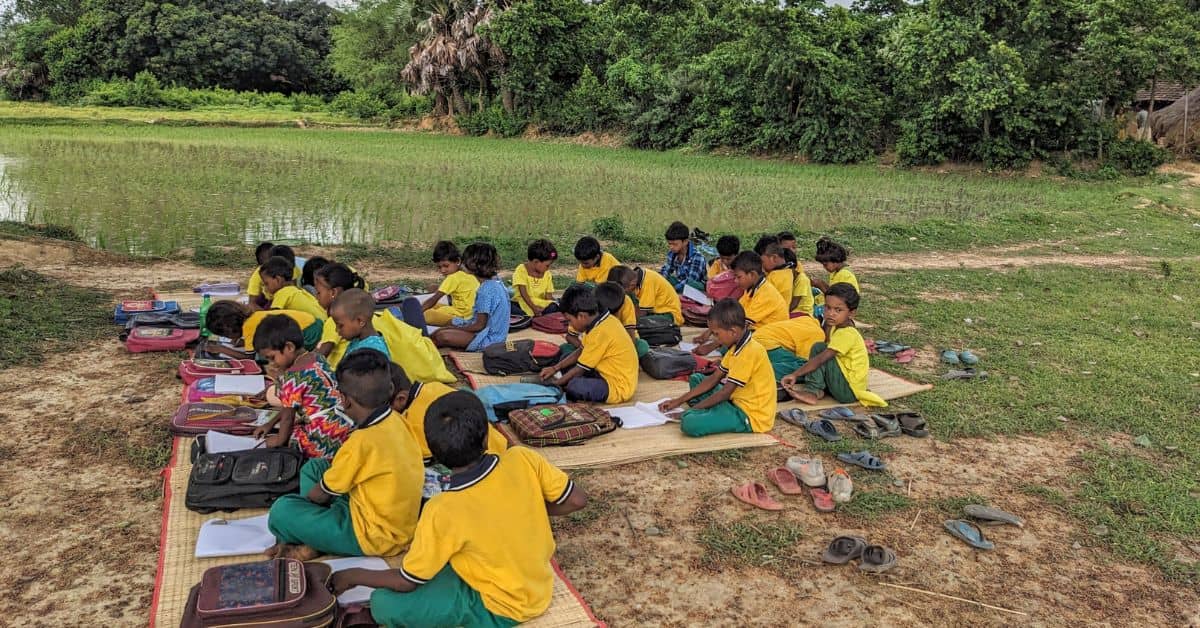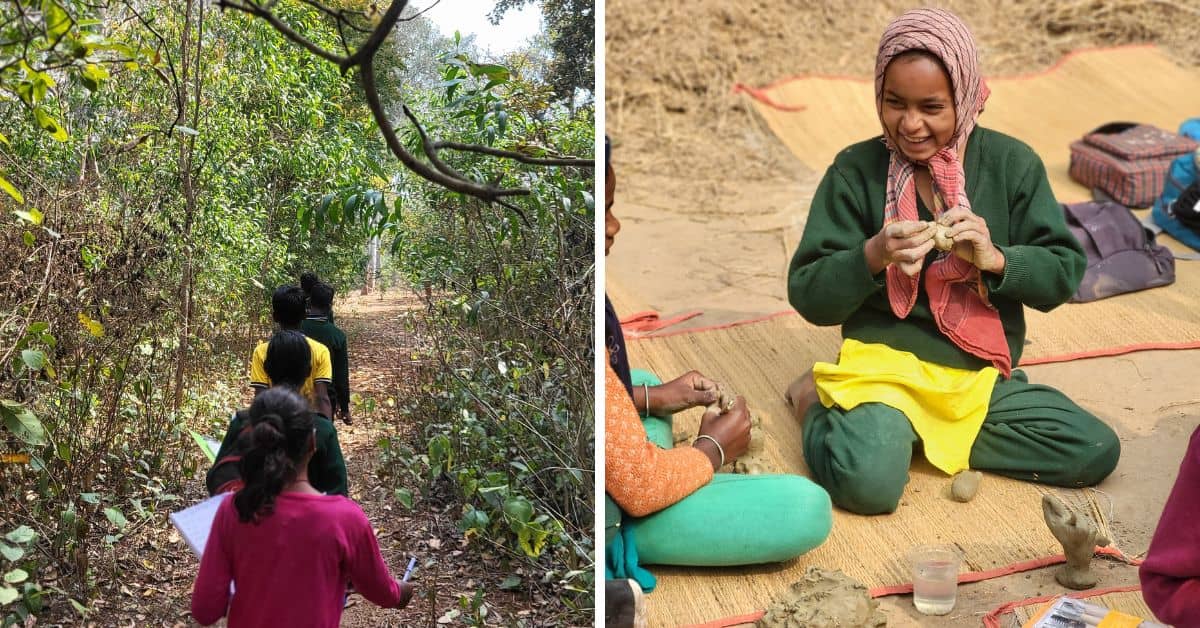Biplab, a class 8 student in the Bagdabra forest area in Murshidabad, West Bengal, is a first-generation learner. Studying in the government school nearby, the COVID-19 lockdown was a big blow for young Biplab and his friends.
Part of the tribal community, many students like Biplab started going to work with their parents as schools were shut. Access to online classes was a distant dream for these children, where basic resources remain out of reach. With no guidance, a hand-to-mouth existence forced these children to ultimately drop out, with schools remaining shut for almost two years.
The tribal communities couldn’t afford the luxury of virtual lessons. Near their village, even before the COVID-19 pandemic, regular tree plantation drives were being conducted. These expanses of green attracted the children, making them regular visitors at the site. As luck would have it, the person conducting these tree plantations was a teacher by the name of Angshuman Thakur.
Noticing the trend of school dropouts and seeing the children accompany their parents to work deeply moved the 40-year-old. Since their schools provided mid-day meals to children, Angshuman first started providing the same to a group of five.
Along with the meals, he also served them spoonfuls of knowledge through his open air classes.
An alumna of Visva Bharati University in Santikentan, he imbibed the principles of Rabindranath Tagore by providing a holistic education in sync with nature, which goes beyond merely words written in textbooks.
Started with five children in 2021, today over 105 children study at Angshuman’s ‘Anirvana Gacher Iskul’ (Anirvana means inextinguishable and Gach means tree). Running on the benevolence of kind strangers and his own savings, it costs Rs 300 per month to educate a child in this school under a tree.
Learning in the lap of nature
Angshuman works as a Bengali literature professor at Prof Syed Nurul Hasan College in Farakka, Murshidabad. Raised in the lap of nature and inspired by Tagore’s teachings, he pursued his higher studies at Visva Bharati university.

Nature had always been his friend and supported him through thick and thin. While going through a tough time personally in 2019, the teacher sought solace in nature again.
“I noticed that the green cover was gradually reducing. I was depressed and wished to utilise my time in a productive manner post work. I put out a Facebook post in 2019 that I was going to plant saplings and people were welcome to join,” Angshuman shares with The Better India.
The response was overwhelmingly positive and led to the formation of the Gach Green Hands Social Welfare Trust whose first agenda was planting 50 saplings on 5 June 2019. Being on the ground led to several interactions with locals and students. The teacher took some of them under his wings and would solve their doubts from time to time.
One of his former students hailed from a village called Samlapur in Farakka and urged him to visit their village. It was after the first lockdown that the teacher visited the village, and he was astonished by what he saw.
“The setting of the village matched Santiniketan. It was beautiful and lush green. I had been meaning to start a school for children, and seeing the village and its children gave me the push I needed,” says Angshuman.
With no financial backing, constructing four walls for a school was also not feasible.
A tribal hamlet, Samlapur housed first generation learners, who were severely affected by schools shutting down. Their parents, who were daily wage workers, had no work and their worsening economic situations forced the children to go to work, dropping out of school.
“Students were heavily dependent on the mid-day meals. The students, who hail from Adivasi families are extremely marginalised. I wanted to ensure that they continue their education,” adds the Farakka resident.
A new age Santiniketan
Anirvana Gacher Iskul, an open air school under the shades of trees was born in 2021 to provide an alternative school to these children.
“The focus in the beginning was providing them basic education and meals. We started with five students and within a week, we had over 20,” smiles Angshuman.
Based on Tagore’s philosophy, the children are taught under neem trees and mango trees. A basic sense of environmental awareness and oneness with nature is inoculated. Concepts are taught by correlating them with what they see around them, instead of focusing on merely bookish knowledge.
Drawing from his own experiences as a student in Visva Bharathi university, the Anirvana school focuses on learning in sync with nature.
“We studied in the open, under trees in Santiniketan, with a focus on nature and culture. Unlike other colleges, where the focus is only on textbooks and curriculum, we are taught to be one with nature. Our creativity is enhanced and out of the box thinking is encouraged,” he adds.
At the Anirvana school too, children are given an opportunity to learn drawing, artwork, dance, music and sports. Professional artists visit the school and teach the children simple clay modelling and other art forms.
“Most of these children are naturally very creative and very good at drawing and clay model making. We want them to explore their talent with locally available materials,” he adds.

After the schools reopened, the school continued to function before school hours. School starts at 6:30 am and provides breakfast. They follow the government curriculum, but with a twist.
“We teach them poems, stories, history from their syllabus with live examples found in nature. We help them relate whatever we teach with native examples. For example, if they are learning about flowers, we try to show them whatever followers are locally available which improves their understanding and leads to an appreciation of their surroundings,” he adds.
Teachers are encouraged to teach this way, without poring over the books. Seeing the success of the school, the village mukhiya (head) gave them the community centre, where classes are conducted during the rainy season.
Going ahead, Angshuman hopes to purchase some land and set up a school with an eco-friendly campus. He also wishes to set up a computer lab and library for the children.
“Through this initiative and the children, we hope to improve the economy of the village. We are sowing the seeds of entrepreneurship in these children, which will reach the community and improve their livelihoods,” says Angshuman.
The school currently has 105 students from kindergarten to Class 12 and seven teachers. It costs Rs 300 per child per month, which is Rs 3,600 per year.
You can support a child by donating through UPI on 7001714095@axl or here:
Account no: 41165791703
Name: Gach Green Hands Social Welfare Trust
IFSC: SBIN0018784
Edited by Padmashree Pande, Images Courtesy Angshuman Thakur.
No comments:
Post a Comment